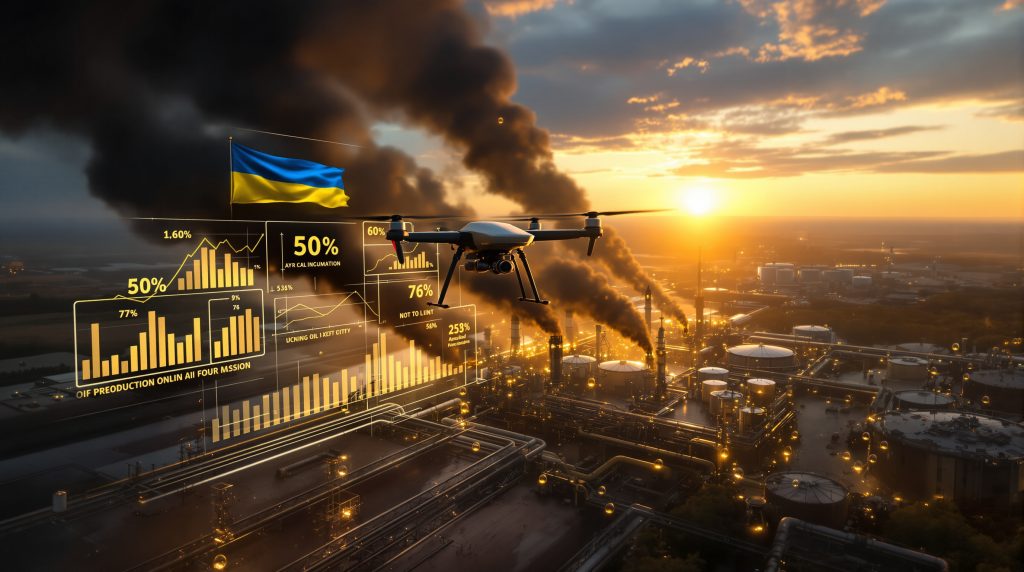The Strategic Targeting of Russia's Energy Infrastructure
Ukrainian drone attacks on Russian oil infrastructure have intensified in 2025, creating significant challenges for Russia's petroleum sector. These precision strikes target critical components of Russia's oil export chain, from refineries to port facilities, threatening to disrupt one of Moscow's primary revenue sources. With each successful attack, Ukraine applies pressure on Russia's ability to maintain current production levels, potentially forcing output reductions that could have global market implications.
The frequency and effectiveness of Ukrainian drone strikes have increased dramatically in recent months. These attacks have systematically targeted vulnerabilities in Russia's oil infrastructure network, causing operational disruptions that compound over time. Intelligence reports indicate a coordinated strategy focused on maximizing economic impact while minimizing civilian casualties.
What Facilities Have Been Hit by Ukrainian Drones?
Major Refineries Under Attack
Ukrainian forces have successfully targeted several strategically important oil refineries across western Russia:
-
Kirishi Refinery: This 355,000 barrels-per-day facility in the Leningrad region suffered significant damage, forcing Surgutneftegaz to reduce processing operations. As one of Russia's largest diesel and fuel oil producers, this disruption creates immediate supply chain challenges.
-
Ryazan Refinery: With a processing capacity exceeding 260,000 barrels per day, damage to this facility has impacted Russia's domestic fuel supply and export capabilities.
-
Multiple Secondary Facilities: At least eight additional refineries have experienced varying degrees of damage from drone strikes, creating a cumulative effect on Russia's refining capacity.
Critical Export Infrastructure Damage
Beyond refineries, Ukrainian drones have successfully targeted key export facilities:
-
Primorsk Port Terminal: This Baltic Sea export hub has experienced multiple strikes, damaging loading equipment and storage facilities essential for maintaining export flows.
-
Ust-Luga Export Terminal: Another critical Baltic port facility that has suffered operational disruptions from targeted attacks.
-
Pipeline Connection Points: Strategic nodes in Russia's vast pipeline network have been damaged, creating bottlenecks in the transportation system.
Why Are These Attacks Threatening Production Cuts?
The Transneft Warning
Russia's pipeline monopoly Transneft has issued a critical warning to oil producers that may force production cuts. This state-owned entity, responsible for transporting over 80% of Russia's crude oil, faces multiple operational constraints:
-
Limited Storage Capacity: With damage to export terminals and refineries, Transneft's ability to store excess crude has reached critical limits.
-
Pipeline System Pressure: The company has warned that it may need to accept less crude from producers due to downstream bottlenecks.
-
Logistical Constraints: Alternative export routes cannot fully compensate for damaged infrastructure, creating systemic pressure throughout the network.
The Domino Effect on Production
The relationship between export capacity and production levels creates a potential domino effect:
-
Storage Limitations Force Choices: When storage tanks reach capacity, producers must either find alternative export routes or reduce output.
-
Repair Timelines Extend Impact: Some damaged facilities require months of repairs, prolonging the disruption beyond immediate tactical responses.
-
Alternative Export Routes Face Constraints: Rail and truck transport cannot match pipeline efficiency, creating bottlenecks that further pressure production.
What Is the Economic Impact on Russia?
Oil Revenue's Critical Role in Russian Finances
The attacks target a crucial economic lifeline for Moscow:
-
Budget Dependency: Between one-third to half of Russia's federal budget comes from oil and gas revenues.
-
War Financing Implications: Reduced oil income directly impacts Russia's ability to finance its military operations.
-
Currency Stability Concerns: Oil export revenues provide essential foreign currency inflows that help stabilize the ruble.
Production Cut Scenarios and Financial Consequences
If Russia is forced to reduce oil production, the financial impact could be substantial:
-
Moderate Scenario: A 5-10% production cut could reduce monthly revenue by $1.5-3 billion.
-
Severe Scenario: More extensive infrastructure damage could necessitate production cuts of 15-20%, potentially reducing monthly revenue by $4.5-6 billion.
-
Long-term Concerns: Sustained infrastructure damage could require significant capital investment to restore capacity, further straining Russia's financial resources.
How Has Russia Responded to These Threats?
Defensive Measures and Countermeasures
Russia has implemented various strategies to protect its energy infrastructure:
-
Enhanced Air Defense Systems: Deployment of additional air defense assets around critical energy infrastructure.
-
Decentralized Storage Solutions: Distributing crude oil storage to reduce vulnerability to single-point attacks.
-
Repair Prioritization: Expedited repair schedules for the most strategically important facilities.
Alternative Export Strategies
To maintain export volumes despite infrastructure damage, Russia has explored alternative routes:
-
Increased Asian Pipeline Flows: Maximizing capacity through the Eastern Siberia-Pacific Ocean pipeline to Asian markets.
-
Shadow Fleet Expansion: Growing the fleet of tankers operating outside international insurance and tracking systems.
-
Rail Transport Mobilization: Increasing rail capacity for oil transport, despite higher costs and lower efficiency.
What Are the Global Market Implications?
Price Sensitivity to Russian Supply Disruptions
Global oil markets remain responsive to potential Russian supply constraints:
-
Price Volatility Patterns: Market analysts have observed price increases of 1-2% following confirmed attacks on major Russian oil infrastructure.
-
Risk Premium: A sustained risk premium has been incorporated into global oil prices, reflecting the ongoing threat to Russian exports.
-
Regional Price Differentials: European markets show particular sensitivity to Russian supply disruptions due to geographic proximity and historical dependency.
Supply Chain Adaptations
The global oil supply chain has begun adapting to potential Russian production cuts:
-
Strategic Reserve Considerations: Major consuming nations have reviewed strategic petroleum reserve policies in anticipation of possible supply disruptions.
-
Alternative Supplier Positioning: Other major producers have signaled readiness to increase output if Russian production falls significantly.
-
Refinery Reconfiguration: European refineries have accelerated efforts to process alternative crude grades to reduce dependency on Russian supplies.
Are Production Cuts Inevitable?
Critical Factors Determining Production Impact
Several key variables will determine whether Russia must ultimately reduce oil production:
-
Attack Frequency and Effectiveness: Continued successful strikes increase the likelihood of forced production cuts.
-
Repair Capacity and Timelines: Russia's ability to quickly repair damaged infrastructure will influence the duration of any production constraints.
-
Storage Flexibility: The petroleum industry's ability to find alternative storage solutions could provide temporary relief from immediate production cuts.
-
Weather Conditions: Seasonal factors affect both drone operations and repair timelines, potentially intensifying or alleviating pressure on production.
Expert Assessments on Production Outlook
Energy analysts offer varying perspectives on the likelihood of Russian production cuts:
-
Short-term Outlook: Most analysts expect localized production adjustments rather than nationwide cuts in the immediate term.
-
Medium-term Concerns: If attacks continue at current intensity for 3-6 months, significant oil price crash analysis becomes increasingly likely.
-
Long-term Structural Changes: Sustained pressure could force Russia to fundamentally restructure its oil export infrastructure, potentially leading to permanent capacity reductions in certain regions.
How Might This Conflict Evolve?
Potential Escalation Scenarios
The targeting of energy infrastructure creates several possible escalation pathways:
-
Expanded Target Selection: Ukraine could broaden attacks to include natural gas infrastructure or electricity generation facilities supporting oil production.
-
Deeper Strike Capabilities: Technological improvements might enable strikes against facilities deeper within Russian territory.
-
Russian Retaliatory Actions: Moscow could respond with increased attacks on Ukrainian energy infrastructure or escalate in other domains.
De-escalation Possibilities
Several factors could lead to reduced pressure on Russian oil production:
-
Diplomatic Interventions: International mediation efforts might include energy infrastructure in ceasefire arrangements.
-
Seasonal Limitations: Winter weather conditions typically reduce drone operational effectiveness, potentially providing a window for repairs.
-
Adaptive Defenses: Improved Russian air defense systems could reduce the success rate of future attacks.
FAQ: Ukrainian Drone Attacks on Russian Oil Infrastructure
What is the primary goal of Ukrainian drone attacks on Russian oil infrastructure?
The primary objective appears to be economic pressure on Russia by targeting a critical revenue source that funds its military operations. By disrupting oil exports, Ukraine aims to reduce Russia's financial capacity to sustain its war effort.
How much of Russia's oil infrastructure has been affected?
While precise figures remain classified, intelligence estimates suggest that approximately 15-20% of Russia's western refining capacity has experienced some level of disruption, with about 5-10% severely impacted. The attacks have targeted facilities representing roughly 25% of Russia's export capacity.
Could these attacks cause global oil shortages?
While localized disruptions are likely, a global shortage remains unlikely in the short term. Russia produces approximately 9% of global oil supply, but production cuts would likely be partial rather than complete. Additionally, strategic reserves and increased production from other suppliers could offset significant disruptions.
How are Russian citizens affected by these attacks?
Domestic fuel prices in Russia have increased by 10-15% in regions affected by refinery disruptions. Some areas have experienced temporary fuel rationing, particularly for diesel. The Russian government has implemented price controls and distribution management to minimize civilian impact.
What defensive technologies is Russia using to protect its oil infrastructure?
Russia has deployed a multi-layered defense approach including radar systems, electronic warfare capabilities to jam drone guidance systems, physical barriers around critical infrastructure, and traditional anti-aircraft systems. These defenses have had mixed success against evolving drone technologies.
Further Exploration:
Readers interested in learning more about the geopolitical dimensions of energy infrastructure targeting can also explore related educational content at Oilprice.com, which offers ongoing coverage of global energy security issues and market impacts. Furthermore, understanding the broader context of US oil production decline provides valuable insight into how these disruptions might affect global markets.
The potential for Ukraine drone attacks could force Russia to cut oil production has significant implications for energy markets worldwide. In addition, recent policy changes like the Alaska drilling policy shifts demonstrate how geopolitical events can reshape energy strategies. Economic factors such as US tariffs and inflation further complicate the global energy landscape, with tariffs impact investments causing additional market volatility. For the latest developments on this situation, Reuters reports provide up-to-date information on Russia's warnings to oil producers about potential output cuts.
Wondering How to Profit from Major Mineral Discoveries?
Discovery Alert's proprietary Discovery IQ model identifies significant ASX mineral discoveries in real-time, providing actionable investment insights before the broader market reacts. Explore historic returns from major discoveries and their market impact at the Discovery Alert discoveries page and position yourself ahead of the next mining opportunity.




